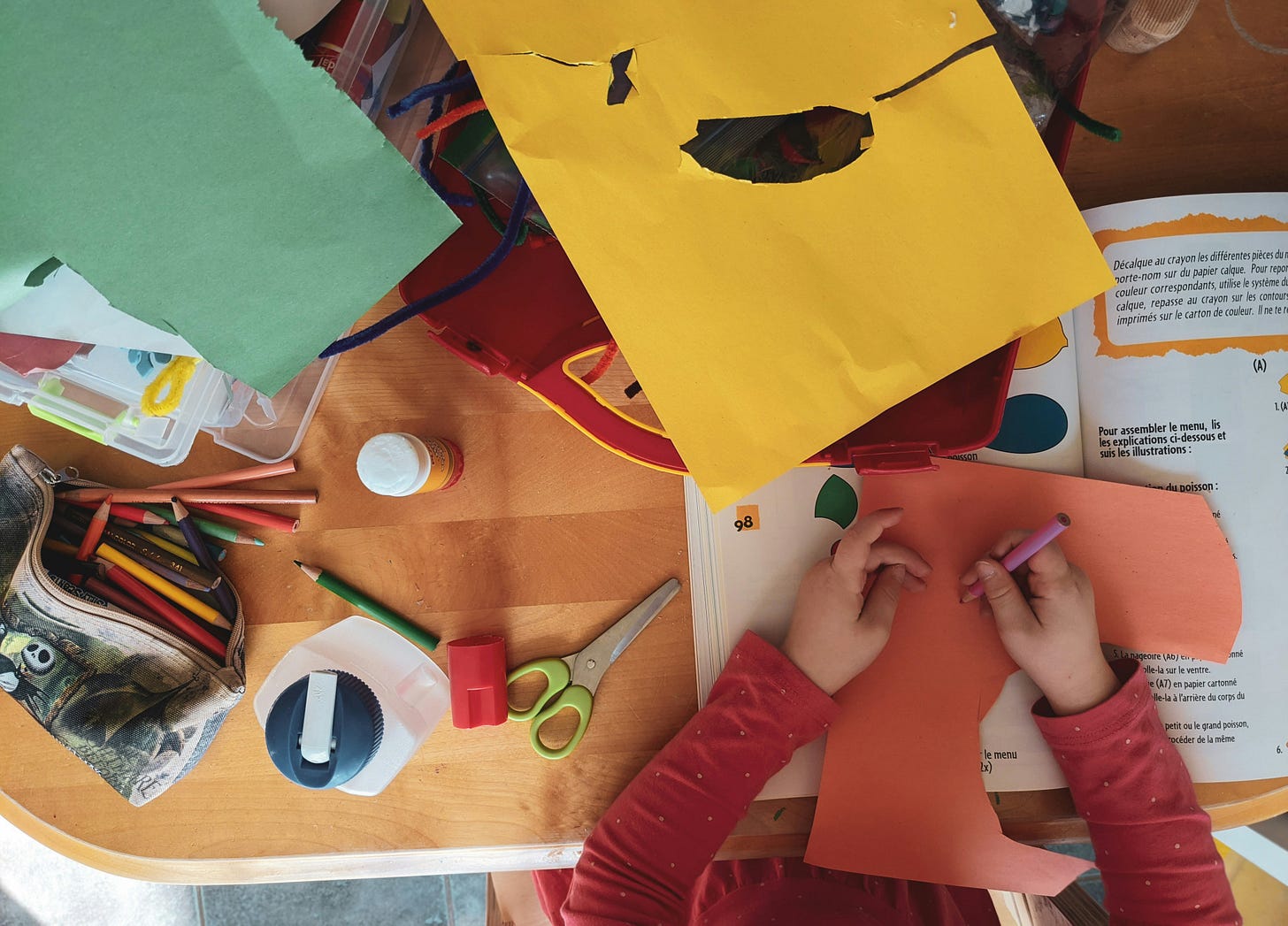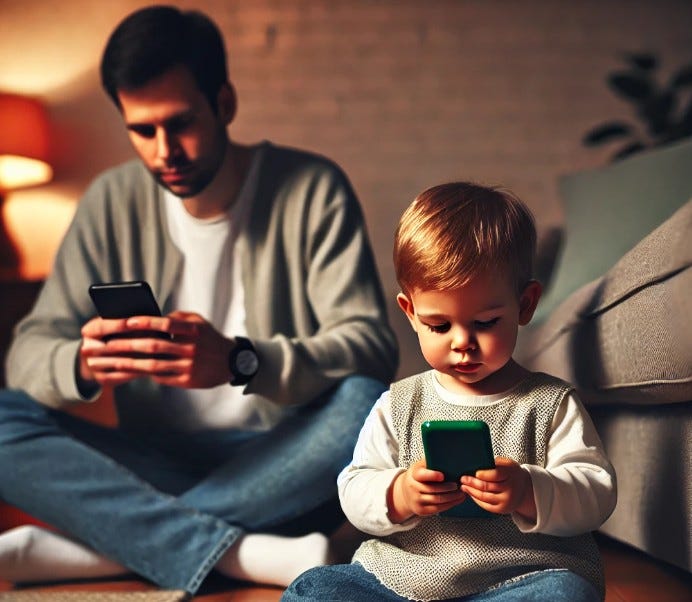We’ve all been there. Sitting in the pediatrician’s office bored out of your mind. You don’t dare look at your phone because you don’t want to look bad when the doctor randomly comes through the door, so you scan the room looking for something—anything—remotely interesting to read.
You skim through a flyer about flu symptoms. Then a brochure about feeding your kids broccoli instead of cookies. You read the label on some lotion on the counter. It’s anti-bacterial, which makes sense, given you’re sitting in a doctor’s office.
And then you see it. The screen time recommendations from the American Academy of Pediatrics (AAP).
You already know what it says and how it’s going to make you feel, but for some reason, you read it anyway:
Under 18 months: Avoid screen time other than video chatting.
Age 18–24 months: Find high-quality programming (if you choose to introduce screen time), and watch or play together.
Age 2–5: Limit screen use to one hour per day of high-quality programs.
Cue the dad guilt.
Because let’s be real—those limits sound impossible. Screens are everywhere. Life is chaotic. Sometimes, you just need to plop your kid in front of Ms. Rachel so you can fold the laundry in peace. And before you know it, that “quick” screen time break turns into hours, and you’re left wondering if you’re ruining your kid’s brain development.
Like you, I’ve read all the articles about why screen time is bad for little kids. I’ve seen the warnings about attention spans, sleep disruption, and social development. But even knowing all of that, it was still hard to actually follow through with limiting screen time.
Because honestly? It didn’t feel that bad.
I mean, these days, there are some great educational shows out there. Ms. Rachel teaches phonics, Bluey encourages imaginative play, and there are even shows that introduce STEM concepts to toddlers. It’s easy to think,
Well, if they’re learning something, it can’t be that bad, right?
But the more I thought about it, the more I started to see different perspectives. What finally clicked for me, and what actually changed my perspective, was realizing that it wasn’t just about what they were watching. It was about what they were missing out on.
I had been so focused on whether or not the content was “educational” that I wasn’t thinking about everything they could have been doing if they weren’t in front of a screen.
That’s what I want to dig into today. Not just why too much screen time isn’t great, but what kids lose when screens take over. Once I understood that limiting screen time didn’t feel like a struggle—it felt like an opportunity.
How Screens Are Stealing Childhood’s Most Valuable Experiences
Think back to when you were a kid. What did you do when you were bored?
If you were like me, you went outside with your friends/siblings to build a fort or make up a ridiculous game to play. Or maybe you just sat on your bed staring at the ceiling, searching for silly faces in the texture.
That boredom, as frustrating as it sometimes felt, was actually doing something important. It was teaching us how to entertain ourselves, solve problems, and think creatively.
Kids today don’t get as many of those experiences. Because when they’re bored, and you’re busy, it’s way too easy to hand them a tablet or turn on a show.
But when screens become the norm, kids lose out on:
Outdoor play (which helps with coordination, risk-taking, and imagination)
Unstructured boredom (which is actually great for brain development)
Deep human connection (because nothing replaces real face-to-face interaction)
Creative play (which builds storytelling skills, problem-solving, and independence)
We recently moved to a new city and have been very fortunate that our new neighborhood has a BUNCH of kids. And with three parks within walking distance of our house, there are always kids running around, riding bikes, playing tag, and just being kids.
It has been an amazing experience watching our kids interact with their new neighbors and friends.
Their sense of exploration and creativity has taken off in a way we’ve never seen before. Every time we go to the park, they play with other kids and come up with new games, build forts, create obstacle courses, and invent entire worlds where everyone has a role to play.
Instead of just following a script from a TV show, they are making up their own stories, their own challenges, and their own adventures together.
Watching them dive into play like this has made me realize that the real value isn’t just in limiting screen time—it’s in making sure they have the freedom and space to explore, imagine, and grow in ways a screen could never replace.
Practical Ways to Cut Back (Without Losing Your Mind)
The problem isn’t that kids watch too much. It’s that they do too little. When screens become the default, they lose opportunities to play, create, explore, and learn in ways that actually stick. And the best way to help? It isn’t just pulling them away from screens. It’s giving them something else to do instead.
Now I know what you’re thinking. So, how do I make that happen without losing my mind?
And let me tell you, you do it a little bit at a time.
Small shifts can make big differences.
Here are some ideas:
1. Replace Screen Time with Hands-On Activities
When kids have opportunities to play, build, and explore, screens become less of a default choice.
Build something:
If I’ve learned anything in the 4 years of being a dad, it’s that kids are pretty good at building things.
Instead of letting your kids watch another episode of a show, pull out legos, blogs, or even cardboard boxes and let them create something from scratch.
Ask them to build a spaceship, a castle, or even a store where they sell imaginary products. If they need inspiration, challenge them: Can you build the tallest tower in the whole world? Or What kind of a house would a superhero live in?
Turn waiting time into a waiting game:
Whether you’re in line at the grocery store, sitting in a waiting room, or waiting for food at a restaurant, resist the urge to hand over your phone. Instead, make a game out of it. Play I Spy, take turns making up a story, or do a quick round of “Would You Rather?”
The goal is to help kids find fun in the little, boring moments instead of always relying on a screen for entertainment.
Set a Daily 10-Minute Outdoor Challenge:
This one’s simple: get outside every single day, even if it’s just for 10 minutes.
Go for a quick walk, kick a soccer ball around, or let your kids climb trees. If they resist, turn it into a game. See who can find the weirdest-shaped rock, or have them pretend they’re explorers on a mission.
What starts as a 10-minute habit often turns into longer stretches of outdoor play.
Recently, I discovered the 1,000-hour outside challenge. This movement encourages parents to spend time outside with their children. The goal is to spend 1,000 hours outside for the year. Now, I know what you’re thinking: That’s an incredibly lofty goal. It’s true that 1,000 hours translates to a little less than 3 hours per day, which, like the AAP screentime guidelines, feels impossible. But honestly, I think that’s kind of the point.
The overarching goal of this challenge is to encourage you and your kids to get outside as much as possible. The cool thing is that even if you “fail” and only get outside 500 hours a year, that still averages out to about 1.5 hours outside every day. That alone is a huge accomplishment.
My advice, start off small and then ramp up as you go. Spending 10 minutes outside is WAY better than spending zero minutes outside.
2. Help Kids Get Comfortable with Boredom
Kids today aren’t used to boredom.
And that’s a problem.
Think back to when you were a kid. How often were you bored? I’d venture to guess it was often. At least once per day.
But kids today live in a world where entertainment is always available, and that means kids don’t often get the chance to sit in boredom long enough to figure out how to entertain themselves.
And that’s a good thing!
Boredom isn’t something to fix. It’s something to let them figure out.
Next time your kid says, “I’m bored,” resist the urge to solve the problem for them. Instead, ask them:
“What else could you do right now?”
If they say, “I don’t know,” don’t rush in with a list of ideas. Give them space to think. It might take a while at first (and they will probably complain), but eventually, they’ll start coming up with their own ideas.
And the more they practice, the easier it gets.
Here are some other ways to help kids build creativity through boredom:
Create a boredom box: Fill a box with art supplies, old magazines, tape, scissors, and random household objects. When they say they're bored, point them to the box and let them create something.
Start a Daily “No Screens” block: Set a specific time each day when screens aren’t an option. At first, they might not know what to do and will likely need some guidance. But over time, they’ll start finding ways to fill that time on their own.
Let Them Be in Charge: Give your kid an open-ended task like, “Make up a game with only these three objects” or “Create a new rule for tag.” When they’re in control, they’re more likely to get invested.
Believe it or not, kids crave boredom. Or at least their biology does. For their development, kids need to experience boredom and learn how to overcome it. When you give them the opportunity to do so, you’ll see them grow, and their creativity will skyrocket.
My older daughter used to have a ROUGH time in the car on long road trips. And since most of our family live in different states than us, we often have to go on long road trips for holidays and vacations, so we end up going on lots of long road trips.
Driving long distances with a screaming child in the back seat is a stressful experience, and for a long time, my wife and I would default to screens to calm our daughter. But we quickly learned that the more we did that, the worse it got.
It wasn’t until we helped our daughter learn to experience boredom that we started to see improvements. We would give her suggestions to sing songs, read books, or create a game. At first, she was very hesitant and complained a lot. But over time, she really learned how to interact with and embrace her boredom.
Fast-forward to last summer when we had three back-to-back family reunions in three different states. She had very few issues with the over 70 hours of driving we did over the three weeks.
Our kids are sometimes more resilient than we realize. Don’t believe me? Test it out for yourself. The next time they are bored, help them use creativity to overcome that boredom and you’ll be amazed at how capable they are.
3. Model the Behavior You Want to See
This one’s tough but SOOO important.
Whether we like it or not, our kids are constantly watching us. If we’re constantly glued to our phones, they notice. Like us, they learn from what we do, not just what we say.
Think about it: If we take them to the park to play but then just sit on the bench scrolling through our phones, what message are we really sending them?
We need to show them that reliance on screens isn’t ideal. To do that, we need to reduce our reliance on screens.
Here are some suggestions on how we can make screen-free time a family effort:
Create tech-free zones: Pick a few places/times in the house where screens are not allowed. Some suggestions could be the dinner table, bedrooms, or during meal times.
Do screen-free activities together: Remember, the goal isn’t to find better ways to distract our kids so we can spend more time disengaged. We are all working to make the most of the time we have with our kids. Instead of telling our kids to put away screens or stop watching TV, do something with them. Go outside, cook a meal together, or create something with them.
Be aware of our own screen habits: Whether on Android or iPhone, we all get that dreaded notification each Sunday telling us how many hours we spend on our phones each day. Next time you get that notification, don’t just swipe it away. Study it, take note of the time you spend on your phone, and make active plans to limit it. Even little changes, like leaving your phone inside while you play outside, can help shift the focus back to the real-world experiences we are striving for.
Our younger daughter is only 1 ½ years old, but very early on, I noticed her wanting to play with my phone so badly. At first, I thought it was just innocent mimicking of what she’d seen me and my wife do. But then I noticed that she would get very upset if I didn’t let her play with it or if I took it away from her. That’s when I realized it probably wasn’t as innocent as I originally thought.
Yes, she was mimicking what her parents were doing, and that is a very age-appropriate thing to do. But was that really what I wanted her to mimic? I realized that my wife and I were on our phones so often that our 1 ½-year-old daughter picked up on that.
It was an eye-opening experience for me and helped me realize that my reliance on screens was influencing my kids in a negative way.
We need to work hard to avoid modeling the behaviors we are trying to teach our kids not to do. It’s not easy, but it’s worth it. Plus, modeling behavior is a two-way street. As our kids see us enjoying screen-free time, they’ll be more likely to do the same.
A Guilt-Free Approach to Raising Kids in a Digital World
The goal here isn’t perfection. It’s progress.
Some days, your kids will play outside for hours and completely forget all about screens. But other days, you’ll be exhausted, plop them in front of the TV, and let them watch way more than you planned. And that’s okay.
The key is to make sure screens aren’t taking over. We don’t want screens to replace the real-world experiences that actually help our kids grow.
So instead of stressing about how much time they’re spending on screens, start asking:
What real-life experiences do I want my kids to have today?
That’s the question that changed everything for me. And once I started thinking that way, limiting screen time stopped feeling like a battle and started feeling like an opportunity both for me and my kids.







The change of perspective from the type of content to the opportunity cost of screen time is spot on! Thanks for sharing.
This is so spot on, and relatable and I’m going through screen weaning for myself and toddler too.